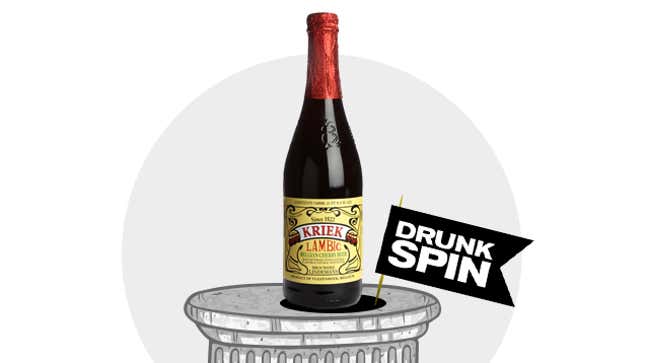
Remember Palcohol, the booze powder that had all our blogs in a bunch last spring before it faded away into some kind of regulatory purgatory for just long enough to let us get all fired up about Ebola, bad weather, Bud Light Mixxtails, and all the other dire threats to our collective future as pertains to survival and Happy Hour? Well, it's back. Powdered alcohol has returned!
Well, more accurately, powdered alcohol is threatening to return; I still haven't heard any reports of it being spotted in the wild. Last week, Palcohol was approved by the Alcohol and Tobacco Tax and Trade Bureau, but as of this writing, it still exists merely as a revived terror-muse for TV-news correspondents and other self-appointed Protectors of the Youth. But let's assume it's coming. Neat! I've got nothing against reconstitutable freeze-dried liquor dust.
Of course, I also don't think it's going to taste good or serve any particular interest of mine, which is why the official Drunkspin review will almost certainly be punted over to the Beer Idiot. But no, I have no qualms with Palcohol's existence. I don't know why anyone would want to go through the bother of turning powder and water into booze instead of just starting with wet alcohol in the first place, but I also don't know why the world has microwave milkshakes and liquid fabric softener. Some people just like to add an extra step, I guess, and that's no business of mine.
The sanctimonious critics of any new intoxicant that doesn't appeal directly to their own lifestyle always tend to circle back to the spurious claim that the innovation in question will lead to an increase in underage alcohol abuse. This is a clever bit of misdirection that takes the focus off their true beef: that a lot of this cheap new shit is tacky. The intermittent prohibitionists who love their own barrel-aged imperial stouts but decry the scourge of Lime-A-Ritas pretend their concern is age-based, but I suspect it's really more about class.
This is why so many of the same people who get up in arms about Four Loko just adore Lindemans Kriek, a super-fruity Belgian lambic that tastes more like a melted popsicle than it does an honest beer. Now, I like Lindemans Kriek, a cherry-juice-spiked brew from a 193-year-old family-owned operation in Vlezenbeek, a small town outside of Brussels. It's good stuff, and at $6 for a 12-ounce bottle of 2.5-percent alcohol-by-volume beer, it's certainly not a budget-friendly way to develop an alcohol problem, which makes it certifiably classy.
But that doesn't prevent it from tasting like the sort of high-end soda pop that has the potential to hook an underage member of the Belgian overclass, or, even worse, seduce a teen with less means into a life of lambic-based crime. Ask the billionaires who install plate-glass windows at pharmacies on the South Shore of Massachusetts if making a drug super-expensive deters abuse. Am I saying Lindemans Kriek is essentially Flemish oxycontin? Maybe—I've sorta lost the thread. What I mean to be saying, though, is that we need to relax about stuff like this.
Maybe it would help to learn something. Lambics are beers that rely on wild fermentation to turn sugar into alcohol, as opposed to the common, uptight method of throwing a particular strain of yeast into the mix on purpose. After the barley and wheat are cooked in the usual manner, the wort is transferred to a koelschip, a sort of metal swimming pool for soon-to-be-funky beer. There it undergoes whatever a beer undergoes when left exposed to the elements, including infestation by wild airborne yeasts and bacteria. That can get a little hairy, which is why lambic brewers use hops mainly for their preservative qualities; they rely on old, dried hops that won't impart much flavor but will keep the weird-science-experiment factor in check.
There are several kinds of lambic, differentiated primarily by aging or blending practices. Lindemans Kriek is a sweetened fruit lambic; they add 25-percent cherry juice to the wort post-fermentation (this is what drags the ABV down so far). This mixture is then pasteurized to prevent secondary fermentation in the bottle, which makes the resulting beer far sweeter than it would be if the yeast had been allowed to eat the sugar from the cherry juice. This is why it tastes more like cherry soda that what a modern American drinker would regard as a sour beer.
Lindemans Kriek is a deep purplish-maroon color that makes it look like highly carbonated red wine, or perhaps expensive grape soda. The bubbles just keep coming forever, forming a pretty pink foam on the top of the glass. It has an intensely sweet dark-cherry smell that's pleasantly reminiscent of Luden's Wild Cherry throat lozenges. The flavor is more complex than the aroma, with hints of lemon, black pepper, and apple, along with some earthiness and a slightly sour tinge, but sticky cherry juice still dominates from beginning to end.
Lindemans Kriek is a fine introduction to the weird world of lambics and other wild beers; the low ABV-to-price ratio might scare off some shoppers of all ages, but then maybe that's what Palcohol's for. Who wants to dump a teaspoon of the magic powder to a bottle of lambic and report back?
This is Drunkspin Daily, the Concourse's adequate source for booze news, reviews, and bullshit. We'll be highlighting a beer a day in this space; please leave suggestions below.
Will Gordon loves life and tolerates dissent. He lives in Cambridge, Mass., and some of his closest friends have met Certified Cicerones. Find him on Twitter @WillGordonAgain. Image by Jim Cooke.
The Concourse is Deadspin's home for culture/food/whatever coverage. Follow us on Twitter.